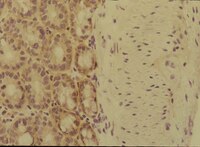Derivation of a new human embryonic stem cell line, Endeavour-2, and its characterization.
Kuldip S Sidhu,John P Ryan,Justin G Lees,Bernard E Tuch
In vitro cellular & developmental biology. Animal
46
2010
Show Abstract
Here, we describe the derivation of a novel human embryonic stem cell (hESC) line, Endeavour-2 (E-2), propagated on human fetal fibroblasts (HFF) in a serum-replacement media. The inner cell mass (ICM) was manually dissected from the blastocyst without using immunodissection and, therefore, antibodies from animal sources. A total of 20 embryos were thawed and cultured, eight embryos were hatched, and five ICMs were obtained. They were transferred onto HFF used as feeder layer, and one colony representing the initial cell proliferation of a new hESC line, E-2, was obtained. The newly emerged hESC colony was passaged first by physical dissection and subsequently by enzymatic dissociation. E-2 has been in culture for over 6 months and has been shown to possess typical features of a pluripotent hESC line including expression of stem cell surface markers (SSEA4, TRA-160, and integrin alpha-6), intracellular alkaline phosphatase, and pluripotency gene markers, OCT4 and NANOG. This hESC line shows lineage-specific differentiation into various representative cell types expressing markers characteristic of the three somatic germ layers under both in vitro and in vivo conditions. E-2 line shows a normal karyotype (46 XX) and has been successfully cryopreserved and thawed several times using slow-freezing procedures. E-2 adds to the repertoire of existing hESC lines for research and development purposes in the field of regenerative medicine. | 20178001
 |
Alterations in integrin expression modulates invasion of pancreatic cancer cells.
Walsh, N; Clynes, M; Crown, J; O'Donovan, N
Journal of experimental & clinical cancer research : CR
28
140
2009
Show Abstract
Factors mediating the invasion of pancreatic cancer cells through the extracellular matrix (ECM) are not fully understood.In this study, sub-populations of the human pancreatic cancer cell line, MiaPaCa-2 were established which displayed differences in invasion, adhesion, anoikis, anchorage-independent growth and integrin expression.Clone #3 displayed higher invasion with less adhesion, while Clone #8 was less invasive with increased adhesion to ECM proteins compared to MiaPaCa-2. Clone #8 was more sensitive to anoikis than Clone #3 and MiaPaCa-2, and displayed low colony-forming efficiency in an anchorage-independent growth assay. Integrins beta 1, alpha 5 and alpha 6 were over-expressed in Clone #8. Using small interfering RNA (siRNA), integrin beta1 knockdown in Clone #8 cells increased invasion through matrigel and fibronectin, increased motility, decreased adhesion and anoikis. Integrin alpha 5 and alpha 6 knockdown also resulted in increased motility, invasion through matrigel and decreased adhesion.Our results suggest that altered expression of integrins interacting with different extracellular matrixes may play a significant role in suppressing the aggressive invasive phenotype. Analysis of these clonal populations of MiaPaCa-2 provides a model for investigations into the invasive properties of pancreatic carcinoma. Full Text Article | 19825166
 |
Lipid defect underlies selective skin barrier impairment of an epidermal-specific deletion of Gata-3.
de Guzman Strong, C; Wertz, PW; Wang, C; Yang, F; Meltzer, PS; Andl, T; Millar, SE; Ho, IC; Pai, SY; Segre, JA
The Journal of cell biology
175
661-70
2006
Show Abstract
Skin lies at the interface between the complex physiology of the body and the external environment. This essential epidermal barrier, composed of cornified proteins encased in lipids, prevents both water loss and entry of infectious or toxic substances. We uncover that the transcription factor GATA-3 is required to establish the epidermal barrier and survive in the ex utero environment. Analysis of Gata-3 mutant transcriptional profiles at three critical developmental stages identifies a specific defect in lipid biosynthesis and a delay in differentiation. Genomic analysis identifies highly conserved GATA-3 binding sites bound in vivo by GATA-3 in the first intron of the lipid acyltransferase gene AGPAT5. Skin from both Gata-3-/- and previously characterized barrier-deficient Kruppel-like factor 4-/- newborns up-regulate antimicrobial peptides, effectors of innate immunity. Comparison of these animal models illustrates how impairment of the skin barrier by two genetically distinct mechanisms leads to innate immune responses, as observed in the common human skin disorders psoriasis and atopic dermatitis. Full Text Article | 17116754
 |
Coordinate control of axon defasciculation and myelination by laminin-2 and -8.
Yang, D; Bierman, J; Tarumi, YS; Zhong, YP; Rangwala, R; Proctor, TM; Miyagoe-Suzuki, Y; Takeda, S; Miner, JH; Sherman, LS; Gold, BG; Patton, BL
The Journal of cell biology
168
655-66
2005
Show Abstract
Schwann cells form basal laminae (BLs) containing laminin-2 (Ln-2; heterotrimer alpha2beta1gamma1) and Ln-8 (alpha4beta1gamma1). Loss of Ln-2 in humans and mice carrying alpha2-chain mutations prevents developing Schwann cells from fully defasciculating axons, resulting in partial amyelination. The principal pathogenic mechanism is thought to derive from structural defects in Schwann cell BLs, which Ln-2 scaffolds. However, we found loss of Ln-8 caused partial amyelination in mice without affecting BL structure or Ln-2 levels. Combined Ln-2/Ln-8 deficiency caused nearly complete amyelination, revealing Ln-2 and -8 together have a dominant role in defasciculation, and that Ln-8 promotes myelination without BLs. Transgenic Ln-10 (alpha5beta1gamma1) expression also promoted myelination without BL formation. Rather than BL structure, we found Ln-2 and -8 were specifically required for the increased perinatal Schwann cell proliferation that attends myelination. Purified Ln-2 and -8 directly enhanced in vitro Schwann cell proliferation in collaboration with autocrine factors, suggesting Lns control the onset of myelination by modulating responses to mitogens in vivo. Full Text Article | 15699217
 |












